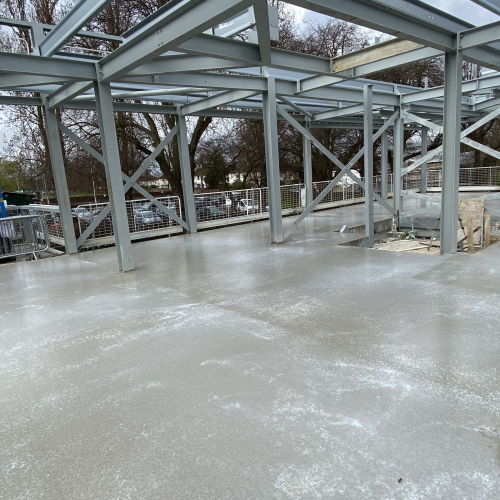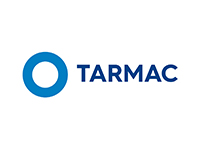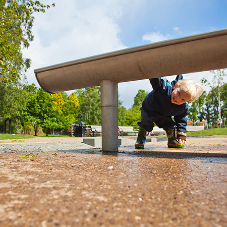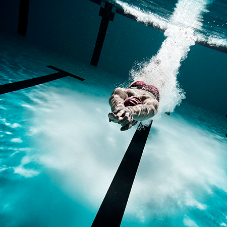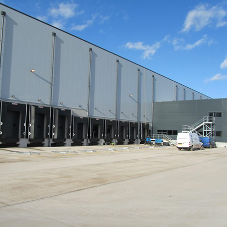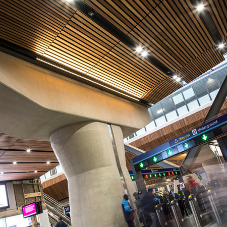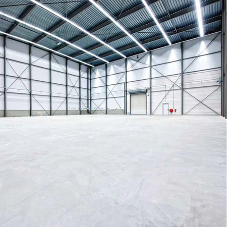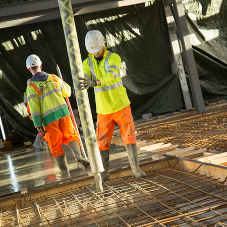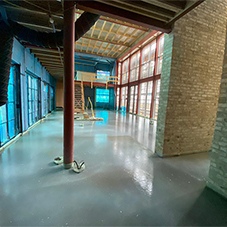This major redevelopment of Charlton Park Academy school involved replacing temporary mobile classrooms and a single storey building with a two-storey steel framed brick building to better meet the needs of students, teachers and carers.
A structural flooring solution was required for use over precast planks, covering 800m2 on the ground and upper floor at a depth of 75mm to 120mm. Space and access would be challenging, due to the small footprint of the site, proximity to the existing school building and access from a busy main road.
Given the large floor area, a traditional sand cement screed would have been very time consuming to place at around 80-100m2 per day.
Handling, cutting and placing the D49 reinforcement mesh within the screed would also be a slow, labour intensive task given the variable thickness and a large number of utilities coming out of the screed on both levels.
As the metal frame building would be open to the weather, the chosen floor solution would need a degree of resistance until it had cured.
After close collaboration between Farrans Construction the main contractor, and Tarmac the materials supplier and comparative analysis of technical data for different materials, Tarmac’s TOPFLOW SF, a self-compacting steel fibre reinforced concrete was chosen as the solution.
Its flowing nature would allow it to be quickly pumped into place and adapt to the variable thickness criteria.
TOPFLOW SF is designed to act as a structural topping with both steel mesh & fibre reinforcement. The steel fibres added to the TOPFLOW SF gave its robustness and flexural strength as it was being placed over a precast plank system that could flex with loadings. They also reduced the risk of cracking.
By replacing steel mesh reinforcement, it helped avoid problems with access, storage and handling and kept the site open for parallel trades.
The pour was completed over two days, 70m3 to each pour. It was placed and finished by the groundworker, Cole Groundworks, for whom it was the first experience of handling self-compacting concrete.
As planned, 140m3 of TOPFLOW fibre reinforced concrete was supplied to the site. The first floor was completed in two pours, each covering 450m2 and the ground floor was completed in a single pour covering 820m2.
Throughout the project, there was close collaboration with local site support provided by Tarmac’s London Readymix technical support team to ensure the quality and consistency of the mix and provide advice on placing and finishing.
The quality of the surface allowed floor finishes on the first floor to be directly applied without the need to power float. Using TOPFLOW SF rather than a sand cement screed or reinforced concrete, improved productivity and saved time. This saved 13 days or just 2.5 week son the programme.
Since their groundwork contractor, Cole Groundworks, completed the pours, Farrans did not need to engage a screeding contractor on this job which saved the related times, activities and made the trades management that much easier.
Ryan McGreevy, Project Manager, Farrans, commented: “Tarmac’s TOPFLOW SF concrete was perfect for what we needed at Charlton Park Academy. This building needed to be finished to a hospital grade standard as this new facility provided additional ground floor teaching space and first floor residential facilities to SEN pupils and support staff.
“Quality of build and products were very important. We faced a number of logistical challenges which made TOPFLOW SF a great option. We had a very tight site footprint and an access we shared with the Academy. If we had a traditional pumped sand and cement screed option, this would have taken over the full compound. Its loss for a number of weeks on each floor would have been detrimental to the project.
“Having all pours completed within a day and on Saturdays was the only and best option. On both floor completions due to the high-quality finish, we were able to go directly onto floor finishes when required without additional concrete finishing works.
“On the ground floor after insulation and pour preparation, which took around a week to complete, the pour was completed in one day on the Saturday with operatives working on the ground floor slab that Monday, saving a considerable amount of time, and greatly favoured the logistical challenges faced on the project.”
Since TOPFLOW is produced with a 40% GGBS content, there was also reduced carbon footprint compared to conventional sand cement screeds or traditional power float concrete mixes. Using this solution saved 61kgCO2e/m3 when compared to the dry sand cement screed it replaced, a net carbon saving of 8.5 metric tonnes of CO2 the equivalent to the emissions generated by cars travelling an estimated 71,237 kilometres or taking five cars off the road for a whole year.
View Free-flowing, self-compacting concrete - Topflow Product Entry

